|
Insignia
EGA Marine Device
.
Bronze collar insignia and
cap
device for enlisted personnel
|
. |
The eagle, globe and anchor (EGA)
of the Marine Corps in bronze was worn on the winter ervice uniform.
The cap device had a rope attached to
the anchor unlike the smaller collar devices.
The collar insignia were worn with the eagle
vertical to the floor and the anchor ring pointing outwards. |
.
| The Marine devices in brass were
worn on all summer uniforms by enlisted personnel. |
. |
Brass collar insignia and
cap device
for enlisted personnel
|
.
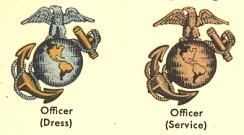 |
.. |
While the collar insignia for officer's and
enlisted personnel were identical in design, the cap devices were slightly
different.
In the ornament for officers, the rope was
free from the anchor in several places. For enlisted personnel, the rope
was not cut away from the anchor.
Additionally, the officer's cap device and
collar insignia for the summer uniform were not brass all over, but silver
and gold. |
.
Bronze Marine buttons.
The smaller button was used
for the epaulets.
|
. |
Buttons
.
Bronze Marine buttons embossed with the eagle,
anchor and 13 stars were worn on the winter service uniform.
In addition, brown plastic buttons were used
due to metal shortage. |
. |
Brown plastic button
|
.
|
Green plastic buttons
|
.v |
Green plastic buttons were worn on the green
and white striped seersucker summer uniform.
The white summer dress uniform was equipped
with gilt buttons. |
.v |
Gilt button
|
...
Rank Insignia
.
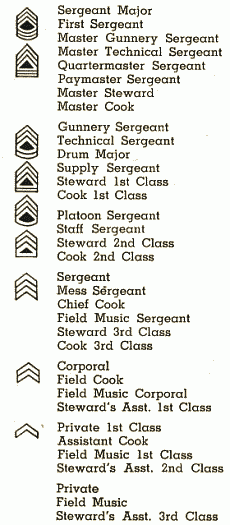 |
. |
Enlisted Personnel
Noncommissioned officers (NCO) and privates
first class were identified in rank by chevrons.
There were two types of chevrons - those tied
together in arcs (belonging to the line branch) and those tied together
by bars (the staff branch).
A specialization in either line or staff began
when a Marine advanced from private first class, but until the third grade
is reached and an arc or a bar is acquired there is no way to distinguish
between both.
There were seven branches from which Marines
could choose their course of advancement: line (which had specializations
within it), aviation, mess, paymaster, quartermaster, music, radio and
signal. The line was distinguished by arcs; the staff, which included all
other branches, by bars.
Privates had no chevrons. |
.
Officer's Rank Insignia
.
At first, Ms. Ruth Chaney
Streeter was commissioned with the rank of major.
On 22 November 1943, she
was promoted to lieutenant colonel.
On 1 February 1944, she received
the rank of colonel.
.
Medals and Ribbons
.
Service and Campaign Medals
.
Below is a list of decorations that women Marines
could receive for their service generally and for service in campaigns
during WWII.
American Campaign Medal

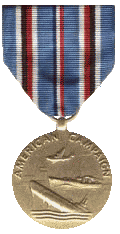
|
.. |
Awarded for service within the American Theater
from 7 December 1941 past the end of World War II. The American Campaign
Medal was established per Executive Order 9265, dated 6 November 1942,
by President Franklin D. Roosevelt. The American Campaig Medal was first
issued as ribbon only.
The ribbon design was approved by the Secretary
of War on 24 November 1942. The blue color represents America. The
blue, white and red stripes in the center (taken from the American Defense
Service Medal ribbon) refers to the continuance of American defense after
Pearl Harbor. The white and black stripes refer to the German flag colors
(the enemy at the Atlantic Coast) while red and white stripes are for the
Japanese colors and refer to that part of the conflict on the Pacific Coast.
The American Theater included North America,
the Caribbean and certain Atlantic and Pacific islands and South America.
The service had to last at least a period of 30 consecutive days or 60
nonconsecutive days.
On 17 December 1947, the first medal was presented
to General of the Army George C. Marshall. |
| . |
|
|
Asiatic-Pacific Campaign
Medal

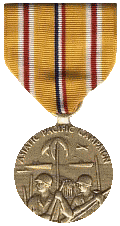
|
|
Alwarded for service within the Asiatic-Pacific
Theater from 7 December 1941 past the end of World War II. The Asiatic-Pacific
Campaig Medal was established per Executive Order 9265 in November 1942
by President Franklin D. Roosevelt.
The ribbon design was approved by the Secretary
of War on 24 November 1942. The white and red stripes on each side
represent the Japanese colors. The blue, white and red stripes in the center
are adopted from the American Defense Service Medal ribbon and refer to
the continuance of American Defense after Pearl Harbor. The medal was first
issued as ribbon only.
The Asiatic-Pacific Theater included Hawaii and
other Pacific Ocean islands, Alaska, Philippines, Australia, New Zealand,
Indonesia, New Guinea and southeast and south Asia as well as the eastern
Soviet Union. Therefore, Women Marines who were serving in Hawaii could
be awarded with this medal. The service had to last at least a period of
30 consecutive days or 60 nonconsecutive days. On 17 December 1947, the
first medal was presented to General of the Army Douglas MacArthur. |
| . |
|
|
WWII Victory Medal

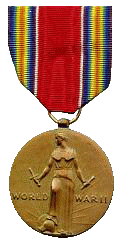
|
|
Awarded to all military personnel
for service between 7 December 1941 and 31 December 1946. The World War
II Victory Medal was established by an Act of Congress on 6 July 1945 (Public
Law 135, 79th Congress).
The specified ending date on December 31, 1946
was the date of the official termination of hostilities as proclaimed by
President Truman.
The Victory Medal was first issued as a ribbon,
and was referred to simply as the "Victory Ribbon" By 1946, a full medal
had been established which was referred to as the World War II Victory
Medal. |
.
.
[ I. Development ]..[
II. Facts about the USMCWR]..[
III. Uniforms ]..[
IV. Sources ]
|
